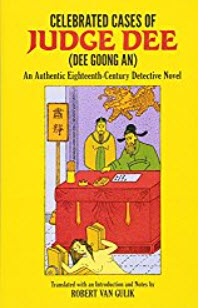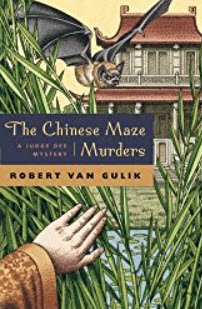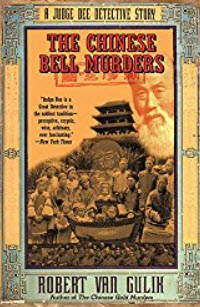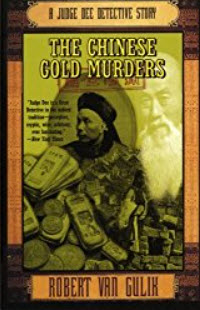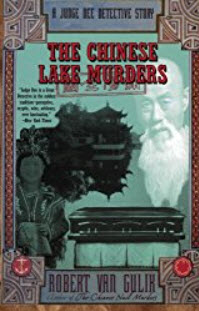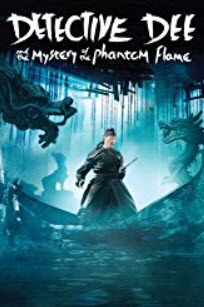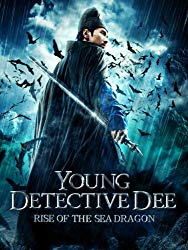Judge Dee
| “As the Chinese have been so often represented—and too often misrepresented—in our popular crime literature, it seems only just that they themselves be allowed to have their own say for once in this field. All the more so because this branch of literature was fully developed in China several centuries before Edgar Allan Poe or Sir Arthur Conan Doyle were born.” |
--Robert Van Gulik (translator), Celebrated Cases of Judge Dee (Dee Goong An): An Authentic Eighteenth-Century Chinese Detective Novel, New York: Dover Publications, Inc., 1976, From the Translator’s Preface, p. I |
Judge Dee--Representative of the Authentic Chinese Detective Story
Before Judge Dee was introduced to the West, stories of
Chinese characters, villains and detectives were often written about by Caucasian writers who
had no knowledge or experience of Chinese people, traditions, history,
religion, philosophy, or actual lifestyle(s).
English author Sax Rohmer, for example, had read a newspaper
account of a Chinese criminal organization being rounded up and arrested in
London. The newspaper story was real but Sax Rohmer created a villainous
Chinese fictional character—Dr. Fu Manchu—purely out of his imagination with no
real knowledge or understanding of Chinese people. The Insidious Dr. Fu Manchu (published in 1914) was the first of a
series of novels that followed the exploits of this “evil oriental genius.”
(This offensive phrase reflected the attitude of many ignorant people who were
suspicious of people they knew nothing about.)
The Fu Manchu books became a template used by other writers
who emulated this negative and false representation.
Another Caucasian writer, Earl Derr Biggers, avoided
following this pattern. Biggers published his first novel—Seven Keys to Baldpate— in 1914 (the same year that saw The Insidious Dr. Fu Manchu in print). Seven Keys to Baldpate was an overnight and international success.
The success of Seven
Keys to Baldpate gave Earl Derr Biggers enough money to marry and travel on
vacation. In Honolulu, Hawaii, he read a newspaper article about Chang Apana, a
Chinese man who had worked for the Honolulu police force for several decades.
Biggers said, “Sinister and wicked Chinese are old stuff. .
. but an amiable Chinese on the side of law and order had never been used.”
Biggers created the fictional Chinese detective Charlie Chan.
While the Charlie Chan novels made great strides in
improving the attitudes of the West toward Chinese people, it also came out of
Biggers’s imagination. Biggers, who studied Literature at Harvard University,
apparently did no research about the Chinese people.
Ernest Bramah (creator of literature’s first blind
detective, Max Carrados) published a series of books about a Chinese
storyteller named Kai Lung.
Examples such as these prompted Robert Van Gulik to write:
| This novel Dee Goong An is offered here in a complete translation. Possibly it would have had a wider appeal if it had been entirely re-written in a form more familiar to our readers. Then, however, much of the genuine Chinese atmosphere of the original would have disappeared, and in the end both the Chinese author, and the Western reader would have been the losers. Some parts may be less interesting to the Western reader than others, but I am confident that also in this literal translation the novel will be found more satisfactory than the palpable nonsense that is foisted on the long-suffering public by some writers of faked “Chinese” stories, which describe a China and a Chinese people that exist nowhere except in their fertile imaginations. (Van Gulik, Celebrated Cases of Judge Dee, pp. VIII, IX) |
How a Caucasian Developed an Authentic 17-Century Chinese Detective Novel and Introduced it to the West
Robert Van Gulik (August 9, 1910— September 24, 1967) was
born in the Netherlands. When he was three years old, his parents moved to the
Dutch East Indies to what is now Jakarta, taking him with them, where they
lived until he was twelve.
Van Gulik studied Mandarin while growing up. As an adult, he
could speak, read, and write Mandarin. He also came to know the Chinese people
and their culture, traditions, and beliefs intimately.
He went home to the Netherlands for his advanced education
(receiving a PhD in 1935). Eventually, he returned to Japan and China. In 1943,
he married Shui Shifang, daughter of a Qing dynasty Imperial Mandarin; together
they had four children.
Van Gulik became a sinologist and an ambassador to China on
behalf of the West.
Van Gulik discovered that China had full-fledged detective
novels in the 17th century. He wanted to introduce these to the West
but there were significant differences between the Chinese of the 17th
century and Western detective stories of the 20th century.
Therefore, he had to find something that would be palatable to Western readers.
17-Century Chinese Detective Stories and the Role of the Judge
These books had titles like Bao Goong An, P’eng Goong An,
and Di Goong An. The first word in
the title represented the surname of the detective; “Goong” is his title as a
magistrate; “An” has to do with one or more cases that the detective may be
investigating.
|
Thus, when Van Gulik translated Di Goon An, he titled the English version Celebrated Cases of Judge Dee. Chinese detective novels of this period follow the actual
protocol of Chinese law and procedure current at the time they were written. I
suppose, therefore, that they can be seen as prototypes of police procedurals. Typically, the Judge investigates three cases during each
book. These cases are separate and unrelated but may overlap in the time
period—an earlier case may be unsolved as another case is initiated,
investigated, and solved. |
Click Image to Click the image below to |
Van Gulik points out that, in his role as a government
official, Judge Dee “performs the functions of judge, jury, prosecutor and
detective.” Van Gulik writes, for example, “This present novel describes
vividly how careful a judge must be to show to the people at large that he
conducts his cases in the right way.”
The Protocol Follows Genuine 17-Century Chinese Law Procedures
The protocol often begins when a citizen wants to lodge a
complaint or report an incident (although the judge himself sometimes initiates
an investigation as a result of something he himself has observed). The judge
is called from his chambers, dresses in his magisterial robe, and takes his
place on a dais in the courtroom. Court, or “Tribunal,” is now in session.
Upon entering the tribunal, the citizen strikes a gong, then
kneels on the floor before the judge and touches his head to the floor several
times. He or she may say something like, “This unworthy person wishes to report
that a body has been discovered on a road in my village. The deceased was last
seen at such-and-such a hotel. I believe that the proprietor of the hotel may
be involved in the victim’s murder.”
The judge has the authority to detain such a person in case
he is making a false allegation or it is later determined that the person has
motivation to lie.
The murdered victim is brought to the court and a doctor or coroner
examines the corpse and reports his observations in great detail. An assistant,
acting as court stenographer, takes notes, which become part of the official
court records. The following quote from the novel explicates this process:
|
The coroner thereupon spread a reed mat on the ground, and had the corpse placed on top of it. He washed it clean with hot water, and then looked over the body inch by inch. He thus reported to Judge Dee: “One male corpse, one knife wound at the back of the shoulder, 2½ inches long, ½ inch broad. On the left side a wound caused by a kick, ½ inch deep, 5 inches in diameter. One knife wound in the throat, 3 inches long, ½ inch broad, a deep cut right through the windpipe”. This report was duly entered in the records by the coroner’s assistants, and the document was placed on the desk of the judge. After Judge Dee had pondered over this report for a few moments, he descended from his chair, and himself carefully looked over the corpse. Having verified the coroner’s report as correct, he affixed his red seal to this document, and gave orders to place the corpse in a temporary coffin, and to put up an official notice to the public, asking all who knew the murdered man to present themselves at the tribunal. (Celebrated Cases of Judge Dee) |
Judge Dee Investigates
In Celebrated Cases of
Judge Dee, the proprietor of the hotel (as alluded to above) is summoned to
the tribunal. He, too, must strike the gong upon entering the court, then kneel
before the judge and touch his head to the floor.
After hearing the allegations, he may respond, “The victim
has indeed stayed at the hotel of this unworthy person. But in the morning , he
ate breakfast, settled his bill, and went on his way. This is the first I have
heard about his death.”
The judge uses his discretion as he investigates the case.
Although modern forensic techniques and tools were unavailable to investigators
at that time, Judge Dee demonstrates great skill and wisdom in his approach. He
provides detailed written reports to his superiors, outlining his course of
action.
During his investigation, the judge is autonomous. In Celebrated Cases of Judge Dee, after
delegating specific instructions for his staff assistants to pursue certain
lines of inquiry, he feels the need to investigate himself while incognito. Van
Gulik translates:
|
At last Judge Dee became alarmed, and thought: “Since I assumed my office in this district, I have solved not a few intricate cases. How can it be that that which is apparently the last phase of this investigation, is so slow in materializing? It is best that I myself set out on a secret investigation to see whether I cannot trace this murderer”. So the next morning Judge Dee rose early, and disguised himself as an itinerant physician. Like a literati, he had a good knowledge of drugs and the arts of healing, so that he did not risk exposure through ignorance of the medical science. Moreover he knew that people in general will tell a doctor more than others. He also reasoned that it was probable that the murderer during the scuffle would have suffered some injuries himself, and, being in hiding, would rather invoke the help of an itinerant doctor, than of a local physician. Shouldering a portable medicine chest well stocked with herbs, pills and powders, Judge Dee set out on his investigation. Celebrated Cases of Judge Dee) |
Some Differences Between 17-Century Chinese and 20th-Century Western Detective Novels
Van Gulik chose to
translate this book over others because he thought it would be more palatable
to Western readers than others of its genre. There are some important
differences, as well as similarities, in the way 17th-century
Chinese and 20th-century Western readers approach this form of literature.
For example, Chinese readers of this time were extremely
detail oriented, which often resulted in a book including so many annotations
and footnotes that a story could be extended into a number of volumes. Dee Goon An had fewer than Van Gulik had
come across in other Chinese detective novels.
The investigation could include consultation with a spirit
medium. For example, the detective or one of his delegates could bring the
chopsticks that the deceased used to eat his last meal and ask the medium to contact
the victim and ask him to provide any details as to the circumstances of his
death.
Or the judge could visit the gravesite of the murdered man,
attempt to commune in a sort of prayer, and ask the victim to give the judge a
dream that could enable him to solve the case.
Although Judge Dee does this in Dee Goon An, the supernatural element is toned down compared to
some other Chinese detective novels of the period. There is plenty of sound,
rational logic and deduction. (Van Gulik points out that some contemporary
Western detective novels employ the supernatural element, as well. For me, John
Dickson Carr comes to mind in this respect.)
Then, too, the judge is allowed to torture suspects to
obtain a confession. But this technique is not to be used lightly: If a suspect
confesses under torture and is executed but later found to be innocent of the
crime, the Judge and his entire staff may be executed in the same manner.
In one case, Judge Dee tortured a suspect who failed to
confess. Dee reported himself to his superiors knowing that, if was unable to solve
the case, he would suffer the same torture himself.
A "7th-Century Chinese 221 Baker Street"
Van
Gulik calls the Judges private quarters a “Chinese 7th century 221B
Baker Street” and describes what Judge Dee may have done during his leisure
moments. He also describes his staff, which includes, among others, Sergeant
Hoong, about whom Van Gulik writes, “This sergeant also serves Judge Dee as a
kind of Watson; for having seen the judge grow up, he can, as an old and
trusted servant, give his master advice, and Judge Dee can freely discuss with
him his problems without losing ‘face,’ or jeopardizing the dignity of his
office.”
At the successful conclusion of a case, the judge sentences
the criminal. To a Western reader, the story is over and we have no further
interest. We “know” the criminal will get his or her just desserts, whether
jail-time or execution. All we want to know is “whodunnit,” or “whydunnit, or
“howdunnit.” We move on to read the next detective, crime, or murder mystery book
on our list.
But
the Chinese reader of this time period wants to see the justice done. Executions are public and are described in
great detail.
One criminal may be tied to a cross and strangled three
times—being revived after each of the first two times and, finally, being
strangled to death.
Another criminal may suffer the “death of 1,000 cuts”—a
long, slow, excrutiatingly painful death involving being cut so many times he or she
ultimately bleeds out and dies after hours of conscious suffering and agony.
So,
finally, Western culture is introduced to an authentic Chinese detective novel.
I find the book a very satisfying read, and the detective work is very good
indeed.
Dee Goong An as a Template for Pastiches
Van
Gulik provides a terrific “Translator’s Preface” and “Translator’s
Post-Script.” He suggests that Dee Goon
An (Celebrated Cases of Judge Dee)
would provide a suitable template for a Western writer to work from in order to
develop pastiches when he writes, “I think that it might be an interesting
experiment if one of our modern writers of detective stories would try his hand
at composing an ancient Chinese detective story himself. The ‘pattern’ is given
in the novel translated here, while in the books listed above one will find a
rich variety of peculiarly Chinese plots. That it is possible to write a fine
detective story, which at the same time is acceptable from a scholarly pointy
of view, is proved by Agatha Christie’s Death
Comes As the End, the scene of which novel is laid in ancient Egypt.” —Van
Gulik, Celebrated Cases of Judge Dee,
pp 231-232).
Then
he, himself, creates a number of pastiches which have been published and are in print and accessible today.
The Judge Dee Books
The
Judge Dee books remain in print today and are highly recommended. The first, Celebrated Cases of Judge Dee, is a
translation by Robert Van Gulik. The subsequent books are pastiches by Van
Gulik.
- Celebrated Cases of Judge Dee (Dee Goon An) [1949]
- The Chinese Maze Murders [1957]
- The Chinese Bell Murders [1958]
- The Chinese Gold Murders [1959]
- The Chinese Lake Murders [1960]
- The Chinese Nail Murders [1961]
- The Haunted Monastery [1961]
- The Red Pavilion [1961]
- The Lacquer Screen [1962]
- The Emperor’s Pearl [1963]
- The Monkey and the Tiger [1965]
- The Willow Pattern [1965]
- Murder in Canton [1966]
- The Phantom of the Temple [1966]
- Judge Dee at Work [1967]
- Necklace and Calabash [1967]
- Poets and Murder [1968]
|
Click Image to Click the image below to |
Click Image to Click the image below to |
|
Click Image to Click the image below to |
Click Image to Click the image below to |
Judge Dee and the Monastery Murders--a Movie Made for Television
A Judge Dee movie, Judge
Dee and the Monastery Murders, was made for television in 1974. Based on The Haunted Monastery, a pastiche that
Van Gulik wrote, the script was credited to Nicholas Meyer, who had written
several Sherlock Holmes novel-length pastiches himself and directed the movie
version of his first—The Seven Percent
Solution.
Judge Dee and the
Monastery Murders was faithful to the Van Gulik novel and I give it high
marks. One wishes it was available on DVD or mp4.
"Detective Dee" Action Adventure Fantasy Mystery Movies
I have viewed Detective
Dee and the Mystery of the Phantom Flame (2010) and Young Detective Dee: Rise of the Sea Dragon (2013) and enjoyed them
for their own merits. At the time of this writing, Detective Dee: The Four Heavenly Kings (2018) has yet to be
released.
|
Click Image to Click the image below to Click Image to Click the image below to |
“Crouching Tiger,
Hidden Dragon meets Sherlock Holmes”
was the promotional tag line for the first film. Some reviewers identify the “Sherlock Holmes”
reference as belonging specifically to the Guy Ritchie/Robert Downey vehicle. Although inspired by the Judge Dee character, the stories that
make up these films are original and fall into the categories of Action
Adventure Fantasy Mystery films, with high quality production values and plenty
of CGI (Computer Generated Image) special effects and stunts. The
character of “Detective Dee” is clearly based on the Judge Dee of the books and
is faithful to the spirit of Judge
Dee. But these films are not based on the books and are more suitable for fans
of martial arts movies, while readers and fans of the Judge Dee books tend to
give them low ratings. |
Amazon and the Amazon logo are trademarks of Amazon.com, Inc. or its affiliates.
(This is a link through which I make a small commission if you buy. See here for more details.)
